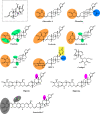The mechanistic role of cardiac glycosides in DNA damage response and repair signaling
- PMID: 37584722
- PMCID: PMC10432338
- DOI: 10.1007/s00018-023-04910-9
The mechanistic role of cardiac glycosides in DNA damage response and repair signaling
Abstract
Cardiac glycosides (CGs) are a class of bioactive organic compounds well-known for their application in treating heart disease despite a narrow therapeutic window. Considerable evidence has demonstrated the potential to repurpose CGs for cancer treatment. Chemical modification of these CGs has been utilized in attempts to increase their anti-cancer properties; however, this has met limited success as their mechanism of action is still speculative. Recent studies have identified the DNA damage response (DDR) pathway as a target of CGs. DDR serves to coordinate numerous cellular pathways to initiate cell cycle arrest, promote DNA repair, regulate replication fork firing and protection, or induce apoptosis to avoid the survival of cells with DNA damage or cells carrying mutations. Understanding the modus operandi of cardiac glycosides will provide critical information to better address improvements in potency, reduced toxicity, and the potential to overcome drug resistance. This review summarizes recent scientific findings of the molecular mechanisms of cardiac glycosides affecting the DDR signaling pathway in cancer therapeutics from 2010 to 2022. We focus on the structural and functional differences of CGs toward identifying the critical features for DDR targeting of these agents.
Keywords: Bufadienolide; Cancer therapeutics; Cardenolide; Cytotoxicity; Structure–activity relationships.
© 2023. The Author(s).
Conflict of interest statement
Not applicable.
Figures




References
-
- Created with BioRender.com.
-
- Jansson D, Dieriks VB, Rustenhoven J, Smyth LCD, Scotter E, Aalderink M, Feng S, Johnson R, Schweder P, Mee E, Heppner P, Turner C, Curtis M, Faull R, Dragunow M. Cardiac glycosides target barrier inflammation of the vasculature, meninges and choroid plexus. Commun Biol. 2021;4:260. doi: 10.1038/s42003-021-01787-x. - DOI - PMC - PubMed
Publication types
MeSH terms
Substances
Grants and funding
LinkOut - more resources
Full Text Sources
Medical
Miscellaneous

